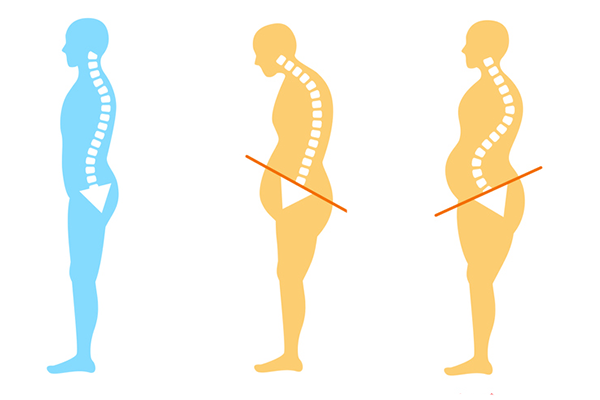You know that feeling when you finally get out of your car after a long drive, and your lower back feels super stiff? Or maybe one side of your hip feels tighter or sore for no clear reason?
Yep, we’ve all been there. And here’s the thing, it’s not just “old age” or “bad luck.” What you’re probably dealing with is something called Pelvic Rotation and Tilting.
Sounds fancy, but it’s actually pretty common, especially if you spend a lot of time behind the wheel. Sitting for hours, stuck in one position, constantly using one leg for the pedals, all of this can mess with your body’s natural alignment and slowly cause your pelvis to tilt or rotate without you even noticing.
What’s the result? Back pain, hip stiffness, and that annoying feeling like your body’s just out of whack after driving.
Let’s make it clearnin a super simple way (because nobody has time for complex medical jargon when their back is already acting up!).
What is Pelvic Tilt?
Your pelvis is like the base of your spine, it holds everything together from your lower back to your hips. When it stays in a neutral position, your posture, balance, and comfort are all in sync.
But when your pelvis tilts forward, backward, or sideways – that’s when problems start showing up. This can cause:
- Lower back pain
- Hip tightness
- Uneven legs
- Discomfort while walking or even standing
So… Why Does Pelvic Tilt Happen While Driving?
Driving is sneaky when it comes to body pain. It looks harmless, but sitting in a fixed position, especially while pressing pedals repeatedly with your right leg, puts uneven stress on your pelvis and spine.
Here’s how:
Your right leg stays active (gas/brake).
Your left leg just rests (passive).
The body naturally starts leaning more to one side.
Your pelvis slowly rotates or tilts without you even realizing it.
This is known as Pelvic Rotation and Tilting. And, the longer your drives, the worse it gets.
Signs You May Have a Driving-Induced Pelvic Tilt
- Lower back pain after driving
- Tight hip flexors
- One hip feels higher than the other
- Pain or numbness in legs or glutes
- Feeling like your posture is “off”
How to Fix This? Stretches Are Your Best Friend!
Luckily, your body loves to move – and stretches are the simplest way to correct pelvic tilt caused by driving.
Here are some easy, practical, and zero-equipment-needed stretches you can do to ease the tension and bring your pelvis back to neutral.
Best Stretches to Correct Pelvic Tilt from Driving
Seated Pelvic Tilts
- Sit upright in your car or chair.
- Gently arch your lower back (tilt pelvis forward).
- Then flatten your lower back against the seat (tilt pelvis backward).
- Repeat 10-15 times.
This loosens up your pelvis and reminds it how to move properly.
Hip Flexor Stretch (Driver’s Worst Enemy!)
- Kneel on your left knee, right foot in front.
- Gently push your hips forward.
- Feel the stretch in your left hip flexor.
- Hold for 20-30 seconds.
- Switch sides.
Driving shortens these muscles – time to lengthen them back!
Glute Bridges
- Lie on your back, knees bent, feet flat.
- Push through your heels and lift your hips.
- Squeeze your glutes at the top.
- Lower slowly.
- Do 2-3 sets of 12 reps.
This is gold for realigning your pelvis and strengthening your lower back.
Figure-4 Stretch
- Sit or lie down.
- Cross your right ankle over your left knee.
- Gently pull your left thigh toward you.
- Hold 20-30 seconds.
- Switch sides.
Loosens up tight glutes from too much sitting.
Exercises for Lateral Pelvic Tilt
Sometimes, one side of the pelvis hikes up more than the other – usually from using the pedals too much on one side. Try the below-listed exercises for lateral pelvic tilt and get the issue fixed:
- Side-lying leg lifts
- Standing hip hikes (on a step)
- Clamshells with resistance bands
These target the muscles around your hips and core that help keep your pelvis level and stable.
Final Tip: Move More, Sit Less
Stretching is amazing, but prevention is always better.
Here’s what you can do daily:
- Take breaks during long drives.
- Adjust your seat for proper hip & knee alignment.
- Stretch before and after driving.
- Be mindful of your posture behind the wheel.
Final Thoughts
Driving might seem like a chill activity, but it can slowly mess up your body alignment if you aren’t careful. Pelvic tilt while driving is super common, but totally fixable.
A few smart stretches, awareness of your posture, and some lifestyle changes can go a long way in helping you stay pain-free behind the wheel. We wish you stay happy and healthy while driving.
